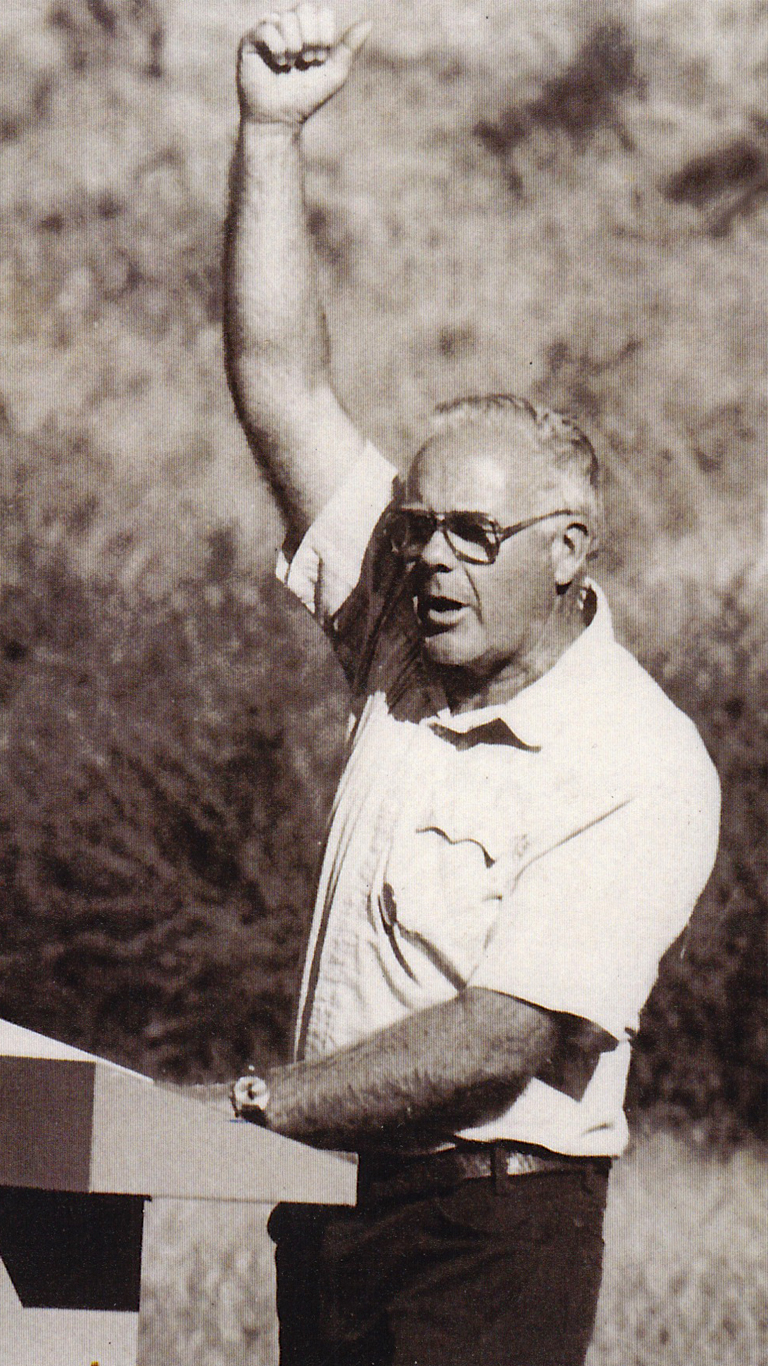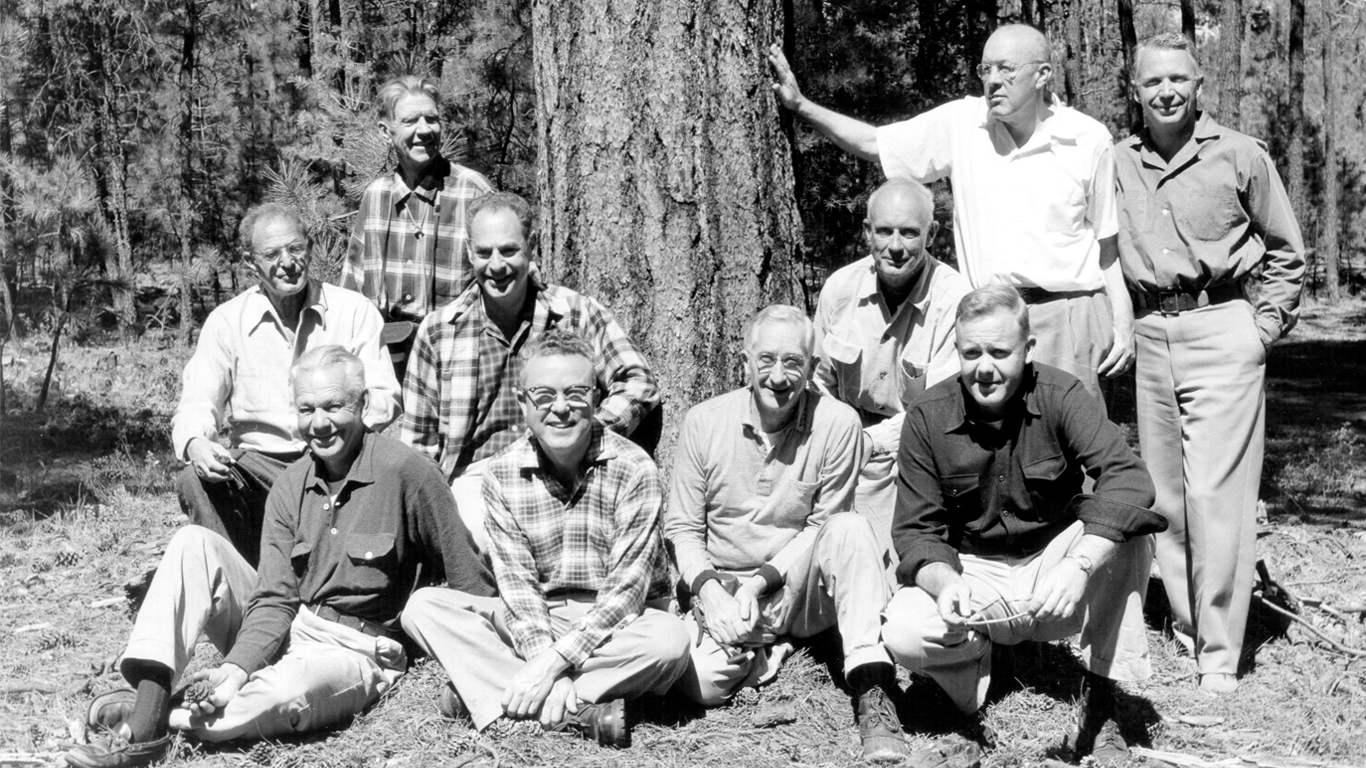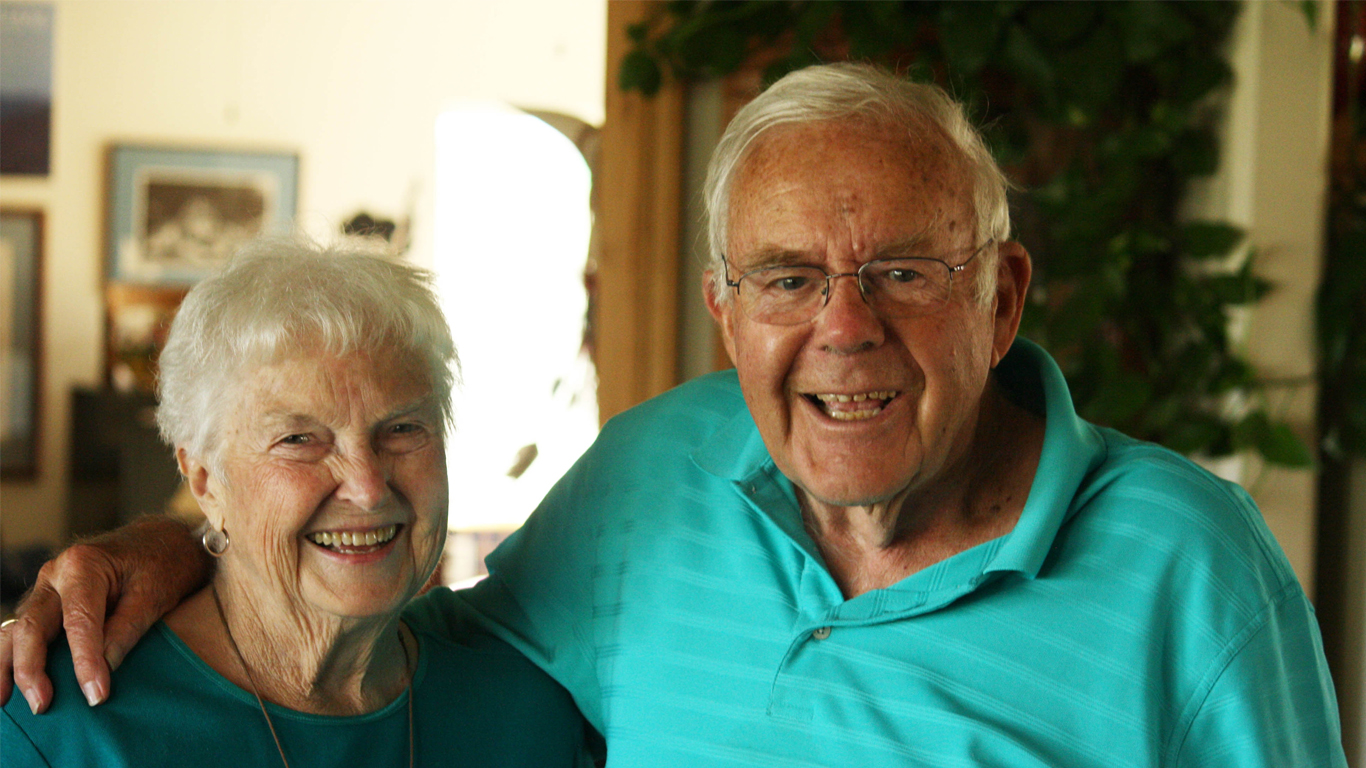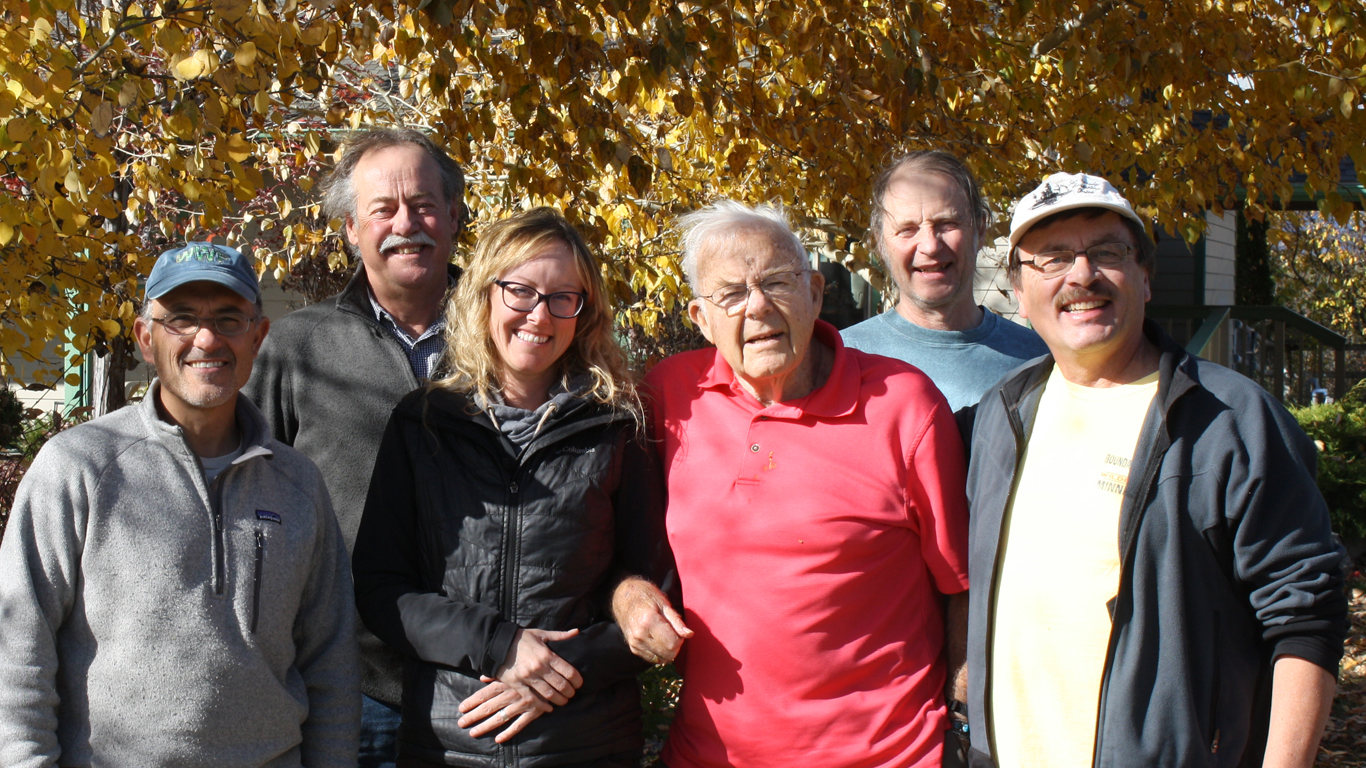Wilderness Giant Stewart “Brandy” Brandborg Moves on at 93
Wilderness Giant Stewart “Brandy” Brandborg Moves on at 93
by Kevin Proescholdt Brandy around 1980On April 14th, wilderness legend Stewart M. “Brandy” Brandborg broke camp one last time from his home in Hamilton, Montana, and headed over the Divide. He was 93.
Brandy around 1980On April 14th, wilderness legend Stewart M. “Brandy” Brandborg broke camp one last time from his home in Hamilton, Montana, and headed over the Divide. He was 93.
Brandy was a giant in the wilderness movement, and the last surviving architect of the 1964 Wilderness Act. A wildlife biologist by training, Brandy conducted groundbreaking field studies of mountain goats in Idaho and Montana in the late 1940s and early 1950s. That work led to a job with the National Wildlife Federation in the Washington, DC, area in 1954. He quickly came to the attention of Howard Zahniser, the executive director of the Wilderness Society. Zahniser recruited Brandy to join the Wilderness Society’s Governing Council in 1956, the same year that Zahniser drafted the first version of the Wilderness Act, so Brandy was in on the ground floor of the eight-year push to pass this landmark bill. In 1960, Zahniser hired Brandy to join the staff of the Wilderness Society, where he worked alongside Zahniser, David Brower of the Sierra Club, and others to pass the bill through Congress.
Not only were there external interests (like timber, mining, and ranching) to overcome to pass the Wilderness Act, but internal challenges as well. Some members of the Wilderness Society Governing Council, like Jim Marshall (older brother of Bob Marshall) and Dick Leonard (head of the Sierra Club), constantly badgered and second-guessed Zahniser and Brandy on their strategies and efforts. Worried that the organization might lose its nonprofit tax-exempt status, they even suggested that the Wilderness Society abandon its effort to pass the Wilderness Act. As the organization’s executive director, Zahniser took the brunt of their criticisms and badgering.
One such point was reached in 1959. But it was the young, eloquent firebrand on the Governing Council who rallied the group to stay the course and push ahead toward final passage of the Act. On October 27th, Brandy wrote an impassioned nine-page letter to the Governing Council. “Our organization has become a major force in the conservation movement,” Brandy wrote. “This is because we stand for something that people need. We have had the finest kind of progressive leadership through the years from Olaus and Zahnie. Now we face a real test and great opportunity to establish a law that will recognize and provide a satisfactory procedure for protecting wilderness. I hope we do not turn our backs on it because of a preoccupation with our organization’s status and financial security….If we fail to meet the wilderness challenge, will others also?” Brandy’s eloquent entreaty fortunately carried the day. The Wilderness Society Governing Council in 1959 at Alpine, Arizona, next to the Blue Range Primitive Area. Back row, left to right: Olaus Murie, Howard Zahniser, Robert Cooney Middle row: Jim Marshall, George Marshall, Ernest Griffith Front row: Sigurd F. Olson, Dick Leonard, Harvey Broome, Stewart M. BrandborgAfter Zahniser’s untimely death in May of 1964, Brandy was selected to succeed Zahniser as the executive director of the Wilderness Society. Brandy helped push the Wilderness Act across the finish line when President Lyndon Johnson signed the bill into law on the 3rd of September 1964.
The Wilderness Society Governing Council in 1959 at Alpine, Arizona, next to the Blue Range Primitive Area. Back row, left to right: Olaus Murie, Howard Zahniser, Robert Cooney Middle row: Jim Marshall, George Marshall, Ernest Griffith Front row: Sigurd F. Olson, Dick Leonard, Harvey Broome, Stewart M. BrandborgAfter Zahniser’s untimely death in May of 1964, Brandy was selected to succeed Zahniser as the executive director of the Wilderness Society. Brandy helped push the Wilderness Act across the finish line when President Lyndon Johnson signed the bill into law on the 3rd of September 1964.
One of the defeats within the Wilderness Act was a requirement that Congress must pass a new law to add each new area to the National Wilderness Preservation System. This provision was insisted upon by the powerful House committee chair, Rep. Wayne Aspinall, no doubt to limit the number of new Wildernesses added to the system. Little could Aspinall have anticipated what he had unleashed.
Part of Brandy’s genius turned this seeming defeat into an incredibly powerful tool to build and expand and activate the wilderness movement all across the nation. Brandy embarked on a years-long process of identifying local wilderness supporters, organizing them, training them on the Wilderness Act, and turning them loose on their state’s Congressional delegations to push for new areas to be added to the Wilderness System. Educator Joe Fontaine of California, for example, now a past president of both Wilderness Watch and the national Sierra Club, was one of those activists recruited and trained by Brandy. Brandy’s efforts paid dividends for decades, long after Brandy’s departure from the Wilderness Society in 1976, and long after the Wilderness Society abandoned its grassroots focus. By the time Brandy left that organization, he had seen the Wilderness System grow by 70 new Wildernesses in 31 states. But the momentum he generated and the wilderness movement he built continued long after 1976, as that wilderness movement convinced Congress to continue adding new Wildernesses to the Wilderness System throughout the 1980s and 1990s. Today we see some 765 Wildernesses in the National Wilderness Preservation System covering 110 million acres in 44 states, a testament to the strength of Brandy’s vision and the movement he inspired.
After he was ousted by the Wilderness Society’s Governing Council in 1976, Brandy worked with the National Park Service during the Carter Administration where he continued to organize training for activists. Brandy always believed that organizing people provided benefits not only for wilderness conservation, but also for society as a whole. “Building the circles” of people enriched the social fabric of the nation, Brandy believed, in addition to finding and organizing activists for wilderness conservation or local planning. Brandy and Anna Vee at their home in May 2013. Brandy and his wife Anna Vee returned to the Bitterroot Valley in Montana in 1986. He never really retired, but continued his wilderness activism for another three decades. He joined the board of directors of Wilderness Watch in 1998, where he served with other such wilderness luminaries as Stewart Udall, Orville Freeman, Joe Fontaine, Michael Frome, and Bill Worf. Brandy served on the board, and later as Wilderness Watch’s Senior Advisor, for a 20-year run from 1998 until his final journey in April. With each visit and phone call, Brandy would ask for the latest updates from the wilderness field, and then hand out our assignments to save all the remaining Wilderness with no compromise and no collaboration. Dedicated and feisty to the end, he gave a final speech to a full house of activists in Hamilton a few weeks before he died.
Brandy and Anna Vee at their home in May 2013. Brandy and his wife Anna Vee returned to the Bitterroot Valley in Montana in 1986. He never really retired, but continued his wilderness activism for another three decades. He joined the board of directors of Wilderness Watch in 1998, where he served with other such wilderness luminaries as Stewart Udall, Orville Freeman, Joe Fontaine, Michael Frome, and Bill Worf. Brandy served on the board, and later as Wilderness Watch’s Senior Advisor, for a 20-year run from 1998 until his final journey in April. With each visit and phone call, Brandy would ask for the latest updates from the wilderness field, and then hand out our assignments to save all the remaining Wilderness with no compromise and no collaboration. Dedicated and feisty to the end, he gave a final speech to a full house of activists in Hamilton a few weeks before he died.
 Wilderness Watch leaders received their next assignments from Brandy in October 2016. All of us at Wilderness Watch extend our condolences to the Brandborg family, and our thanks to them for sharing Brandy with us for so many years. Brandy will continue to inspire the wilderness movement and Wilderness Watch far into the future, and we fully expect to receive our next assignments from him in short order.
Wilderness Watch leaders received their next assignments from Brandy in October 2016. All of us at Wilderness Watch extend our condolences to the Brandborg family, and our thanks to them for sharing Brandy with us for so many years. Brandy will continue to inspire the wilderness movement and Wilderness Watch far into the future, and we fully expect to receive our next assignments from him in short order.
Kevin Proescholdt is Wilderness Watch's conservation director.
When you subscribe to the blog, we will send you an e-mail when there are new updates on the site so you wouldn't miss them.
Contact Us
Wilderness Watch
P.O. Box 9175
Missoula, MT 59807
P: 406.542.2048
Press Inquiries: 406.542.2048 x2
E: wild@wildernesswatch.org
Minneapolis, MN Office
2833 43rd Avenue South
Minneapolis, MN 55406
P: 612.201.9266
Moscow, ID Office
P.O. Box 9765
Moscow, ID 83843

Comments